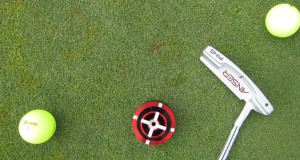A putter shaft can be straight or curved as it approaches the putter head. A shaft can be mounted in the heel or center of the putter head, as well as in between. A shaft can also be mounted into a “hosel,” a joint that extends from the putter head.
Regardless, depending on how the shaft curves and/or how the hosel is constructed, a putter can have varying degrees of “offset.”
In a putter with no offset, the leading edge of the shaft is in direct line with the leading edge of the putter face when looking down at the putter. In a putter with offset, the leading edge of the shaft is slightly ahead of the putter face when looking down (see putter at left for example of offset, putter at right for example of no offset; graphic generously shared by Cleveland Golf).
The term “full shaft” offset means that the offset is equal to the width of the shaft, while ½-shaft offset signifies that the offset is roughly equal to half of the width of the shaft.
Offset putters are preferred by golfers who like to have their hands slightly ahead of the ball during the putting stroke. Some also believe that eye dominance plays a role in fitting offset to the golfer.
In the words of Rife Putters: “For a right-handed player who has a dominant left eye, the eye closest to the hole, we would typically fit them with a straight shafted putter because that puts their dominant eye over the ball. For a person who is right eye dominant, the eye furthest from the hole, we would give them an offset shaft. Putting the ball under the dominant eye helps the player line up the putt with more accuracy. Offset putters typically help golfers keep their hands in front of the ball at impact and promotes less break down in the wrists.”
As with so many things in the world of putting, it ultimately comes down to personal preference and performance.
P.S. For the complete scoop on putter fitting, check out Putter Perfection by Sean Weir, editor of PutterZone.com.
 PutterZone – Best Putter Reviews
PutterZone – Best Putter Reviews






There is also negative offset or "onset" for extreme hole side eye dominance. All straight shaft SeeMore putters are about 1/4 to 1/2 shaft onset to allow for the RST.
The Backstryke putters are about 3 shafts negative at the bend and about 1/2 a shaft at the grip.
The Yes! Amy had a little over a shaft of onset too. That was a strange putter.
All STX putters until fairly recently were onset. I always wanted to try a long version of the Sync putter, which is a full shaft onset. Their new Envision TR is about half a shaft onset and the ProFIT 6 is a full shaft or so onset.
Yes, I should probably do a piece on onset, since the Backstryke broke that category wide open!
In case you are a golf junkie just like I am, you're constantly researching ways to develop your game, because you are reading this article you almost certainly belong to that category. Among the simplest methods to boost your golf performance would be to keep the statistics. Let's be honest, in case you are not really looking to improve your game what is the point? My partner and i end up finding ourself playing the game of golf with high handicap golf players ( not necessarily that there are anything at all wrong with that), nevertheless I think it is exciting that many times they don't really keep their own score.
I have a Scotty Cameron putter (California Montery 1.5). I noticed that the shaft is not exactly perpendicular to the ground when I stand the putter on the floor. The shaft is slightly tilted away from the target. Is this normal? The putter is bought new with no modifications made to it.
Your feedback is appreciated.
Specs:
Loft 4 degrees
Lie 71 degrees
Length 34 inches
Offset 1/2 shaft
Hey there, I can’t say for sure with that specific putter. However, I have noted that certain models by certain companies do have some small degree of tilt. Sometimes it’s toward the target, other times it’s away from the target. To confirm that it’s intentional on your putter (as opposed to an accidentally bent hosel, etc.) you may want to contact Cameron directly or find another one to compare it to. Sorry I couldn’t be of more help!